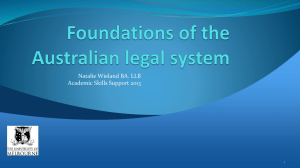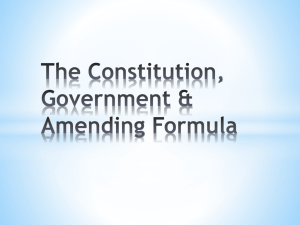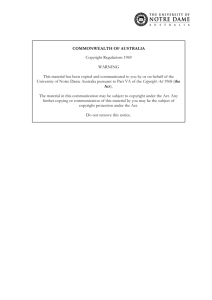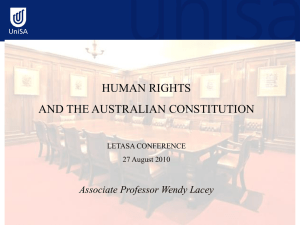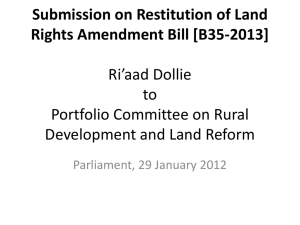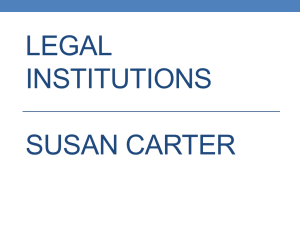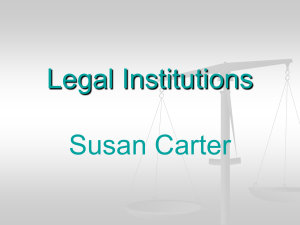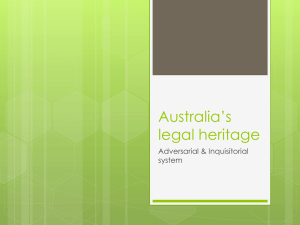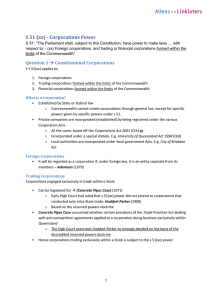Koori Court - WordPress.com
advertisement
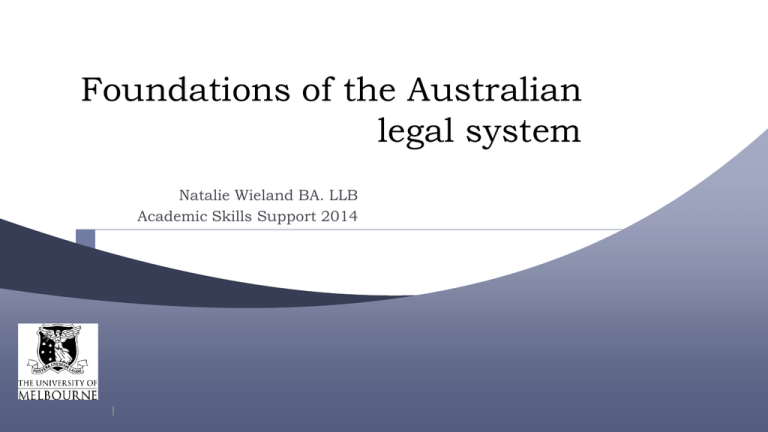
Foundations of the Australian legal system Natalie Wieland BA. LLB Academic Skills Support 2014 1 Overview • Started as a penal colony on 26 January 1788 • Stated the land was “terra nullius” ie/ uninhabited • A number of colonies • Commonwealth Constitution 1901 • Only in recent years acknowledged Aboriginal legal system 2 Federal System The Constitution set up a Federal System with three tiers of government 1. 2. 3. 3 Federal/Commonwealth State Local Governor General • The head of our Commonwealth Government is a representative of the Queen – the Governor General who is currently Quentin Bryce ( a new GG being sworn in in March Peter Cosgrove • Each state has a Governor. In Victoria it is currently Alex Chernov AC, QC 4 Role of Governor General Pursuant to the Constitution advise if the Governor-General •Has to assent to a Bill for it to become law •Can he/she withhold consent •The Governor-General represents the Queen 5 Who deals with what? The Constitution establishes what areas are dealt with by the Federal Parliament. If an area is not listed it remains with the States. We need to look at the Constitution to establish who has what powers. 6 ACTIVITY List which are state and which are Federal powers Family law 7 Roads and traffic Education Lighthouses Rubbish bin collection Postal services Bankruptcy Marriage Immigration Sources of law 8 Common Law (Case law) Legislation – statutes and regulations Court hierarchy 9 High Court of Australia Highest court in the land – no further right of appeal Current Chief Justice – French CJ 10 Koori Court A Koori Court is a division of the Magistrate's court in Victoria, Australia, that sentences Indigenous Australians who pleaded guilty. Koori Courts were created in order to allow participation of the Aboriginal community and culture in the legal system, in an attempt to bridge the cultural differences between Indigenous Australians and the imposed colonial law. They began operation in 2002, and are held on a designated day in an ordinary courthouse. The laws administered are exactly the same as in any Australian courthouse, but the format of the hearing is different. (Wikipedia) 11 LETS WATCH A VIDEO http://www.youtube.com/watch?v=evlXu59uW7o 12 Common law • developed by Judges, usually superior courts (doctrine of precedent) •Each case a solution to a dispute between two or more parties •A series of cases on area of law can form the ‘legal framework” eg. Negligence 13 Doctrine of precedent • rules of common law are found in past cases •English common law employ stare decisis ie. to follow the decisions' of earlier cases 14 Doctrine of precedent •Each court is bound by decisions of courts higher in the hierarchy •A decision of a court in a different or lower hierarchy may be persuasive not binding •A court is not bound by their own decisions •Only the ration decidendi (the reason for deiciding) is binding •Obiter dicta (passing remarks) are not binding but persuasive •Precedents do not lose their force over time* 15 Taken from “Laying down the law” 8th edition pp116-117 Lexis Nexis Law reports The doctrine of precedent requires a comprehensive reporting system in order to find the authoritative decisions. Each jurisdiction has its own authorised version which you must use when citing a case 16 Authorised reports Court It is vital to know which is the authorised version for each court. A full list can be found on the library website at: Library -> Tools – Authorised Reports 17 High Court of Australia Report Abbreviation Commonwealth Law Reports CLR Federal Court of Australia Federal Court Report FCR Supreme Court of Victoria Victorian Reports 1957Victorian Law Reports 18751956 VR VLR Supreme Court of Canada Supreme Court Reports SCR Legislation vs case law The general rule is legislation takes precedence over case law. Therefore, Parliament can always change the case law rules. However, the Courts interpret the legislation and therefore can effect the meaning of the words. Acts Interpretation Act 1901 (Cth) eg. S.15AA the requirement to interpret provisions in accordance with the underlying purpose of the Act • 18 Parliament • • • Federal democratic system – powers set out in the Constitution Commonwealth States (Victoria, South Australia, Queensland, Tasmania, New South Wales, Western Australia) Territories (ACT and Northern Territory) 19 The legislative process • • • An idea is developed into a Bill The Bill passes through Parliament Receives Royal Assent • Governor- General (Federal) • Governor (State) 20 Creating an Act Bill drafted Lower House Upper House GovernorGeneral 21 The Bill has an Explanatory memorandum which helps understand purpose of Bill 1st readings - > Second reading (most important) - > 3rd Reading - > Passed 1st readings - > Second reading (most important) - > 3rd Reading - > Passed Cannot become law until GG (or Governor at State level) signs and then check for commencement details Lower House – House of Representatives 22 Upper House - Senate 23 Subordinate legislation •Not all laws can be made in Parliament – so need the power to delegate and make subordinate legislation. •Most common form are regulations 24 How to change • An amending Act needs to be drafted and passed through Parliament 25 How can I tell if there have been changes • • • Commonwealth Acts – check the notes at the foot of the Act E. Fair Work Act s.12 Victorian Acts – check the margin Eg. Racial and Religious Tolerance Act 2001 s.14 26 Summary Two ways to make law: •Case law (including interpreting legislation) •Legislation 27 Questions? Don’t forget you can always come to the library for help, or the Academic Skills Centre 28
